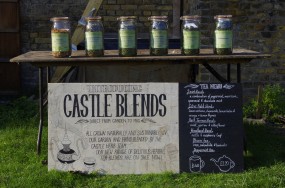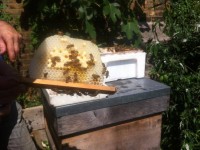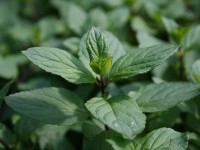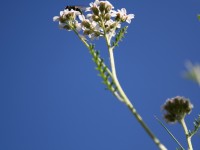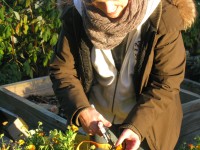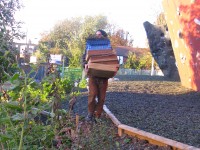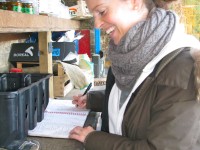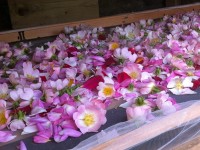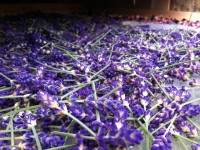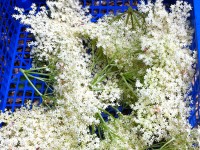‘Direct from Garden to Mug’
Since qualifying as a herbalist in 2011, I’ve built up a large dispensary, consisting mainly of tinctures and dried herbs, which I source wherever possible from organic-certified suppliers. Despite my best efforts to source my medicines in a sustainable way, it bothered me that 9 times out of 10, even common native herbs, like Dandelion and Yarrow, were shipped in from abroad, so that the carbon footprint created by all that transport effectively wiped out many of the benefits of choosing organically-grown herbs. So when I met Ida Fabrizio, Garden Project co-ordinator at the Castle Climbing Centre, earlier this year, I was excited to hear that, as well as supplementing the kitchen with vegetables, herbs and fruit destined for the centre’s fantastic café, they were making their own herbal tea blends and herb balms, grown and processed on site!
The herbs at the Castle are grown predominantly to please the palate, rather than for their medicinal qualities. Nevertheless, as an urban herbalist, deprived of the abundant foraging opportunities provided by a more rural environment, I was keen to find out which herbs would suit this North London ‘terroir’, how easily they could be harvested, dried and processed etc. So, I went along one Monday morning in May to volunteer and meet Nick Quinn, the Castle’s resident expert on growing medicinal herbs.
The first thing Nick did was to offer me a cup of fresh herbal tea (marjoram and thyme) picked from right next to where we were sitting, and sweetened with a dollop of honey produced by the Castle’s own bees. ‘What do you think of this for a new tea blend?” he said. “What could we add to it?” I was so taken by the simple luxury of sitting in the spring sunshine, while the ingredients of the tea I was drinking were growing (or buzzing) right around me, that it took me a while, marinating in all that life-affirming freshness, before I said, “How about Peppermint?” and took another sip.
- Honey from Castle Bees – photo by Ida Fabrizio
- Chocolate Peppermint destined for the Castle Tea Blends
- Yarrow destined for the Castle Herb Terrace Blend
I soon learned that the Garden was full of variety. To date, I have counted (and am still counting) well over 40 medicinal herbs that are either grown deliberately for harvest, or can be foraged. Once you count in the different varieties of mint, say, or marjoram, or thyme, then the number is probably greater than 50, including flowers, such as roses, marigolds and lavender (which make up our ‘Bloom Tea’), leaves, such as lemon verbena, peppermint, raspberry leaf and thyme, and (of course!) climbers such as hops and honeysuckle.
Spring and Summer are the busiest times for Nick & Jack, the herb and herbal product co-ordinator. All the plants in the garden, including the herbs, are raised using only natural methods. No artificial pesticides or herbicides are used and the plant feed is made from Comfrey grown in the garden. The Castle Garden also makes and uses its own compost. The garden was designed with sustainability in mind, and as luck would have it, most of the herbs used in the tea blends and herbal products are hardy perennials, or annuals that self-seed like Calendula, which helps to minimise the need to disturb the soil with digging and replanting each year, and to reduce maintenance overall. Perennials and perennial-like annuals like mint and calendula provide a steady cut-and-come again harvest throughout the main growing season.
Where plants have a shorter harvest season, such as lavender, the variety of herbs grown in the garden means that when one herb comes to the end of its season, others start reaching their peak, effectively smoothing out the workload. Roughly a quarter of the herbs currently used in our tea blends are foraged sustainably from trees and wild plants in the garden, such as elderflower, rose and nettle, and all the rest are harvested by hand from beds or from the forest garden. That said, the herbs don’t garden themselves (!), and the hard work and enthusiasm of garden volunteers who come in every Monday to help sow, plant, water, weed, harvest, dry and process the herbs makes all the difference when you see (and taste) the finished product. As a herbalist, I should know!
- Harvesting Calendula flowers for tea – photo by Anne Quinn
- Nick carrying drying trays – photo by Anne Quinn
- Making a record of the Harvest – photo by Anne Quinn
In keeping with the Castle Climbing Centre’s Sustainability Goals, herbs from the garden are dried as far as possible using the energy of the sun, before being finished with a short burst in an electric dryer. A solar dryer is a weatherproof space in which plant material can be dried using nothing but the energy from the sun. In this case, Nick made use of the space underneath the black metal stairwell on the south side of the Castle to create a ‘walk-in’ solar dryer, with the platform at the top of the stairwell forming a black roof that collects sunlight and converts it to heat. The space underneath is well ventilated so that cool air is drawn in and warmed up, and then passes through the stacks of upcycled mushroom trays where we lay out the herbs. In the heat of the Summer, many of the herbs dry in a matter of days, and even now, in Autumn, we can save a considerable amount of electricity by leaving herbs to dry for a week or so before finishing them off for an hour or two in the electric dryer.
- Rose petals laid out to dry in the solar dryer
- Lavender laid out to dry in the solar dryer
- Elderflowers ready for drying in upcycled mushroom trays
When we harvest herbs for their leaves, as we do with all the mints (Moroccan mint, Spearmint, Peppermint & Chocolate Peppermint), and with Lemon balm and Lemon verbena, we strip the leaves off the stalks before they go into the solar dryer as this greatly reduces the time it takes them to dry. Plants with fleshier leaves and high essential oil content like Sage (just rub a fresh sage leaf between your fingers and you’ll feel how thick and sticky it is, compared say, to mint) take the longest to dry, whereas plants like Lemon verbena, which has paper thin, delicate leaves, dry in no time at all. One way or another, the stalks must be removed before the final, dried product is ready to be included in a blend, or used on its own as a ‘simple’ tea, like peppermint. Plenty of flowers go into the blends too, not just for their delicate scents and aromas, but also for their beautiful and often vibrant colours, which we take care to preserve by drying and storing the petals in the dark. Direct sunlight will fade the colour of most flowers and leaves, making the final product look dull and lifeless, as opposed to a feast for the eyes, and as Nick put it, ‘a festival for the senses!’
Right now, as well as planting up new herb beds, we’re looking to build up a strong team of volunteers with a particular interest in learning about herbs and how to grow them, and there are plans to take on a Herb apprentice for next year’s growing season, similar to the Garden apprentice who currently assists with the fruit and vegetable production. In November, in addition to our usual Monday Herb volunteer days, we’ll be holding two dedicated herbal product making days on 11th and 18th to prepare a variety herbal gifts for the café to sell during the festive season. We always welcome new volunteers, so if you’d like to join our Herb team, please get in touch.
